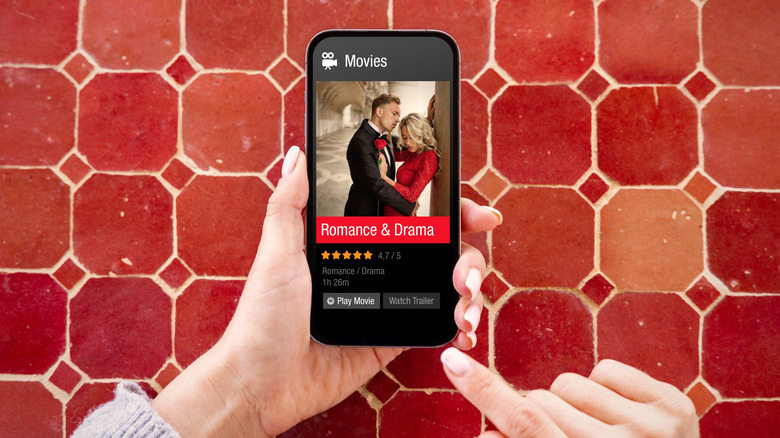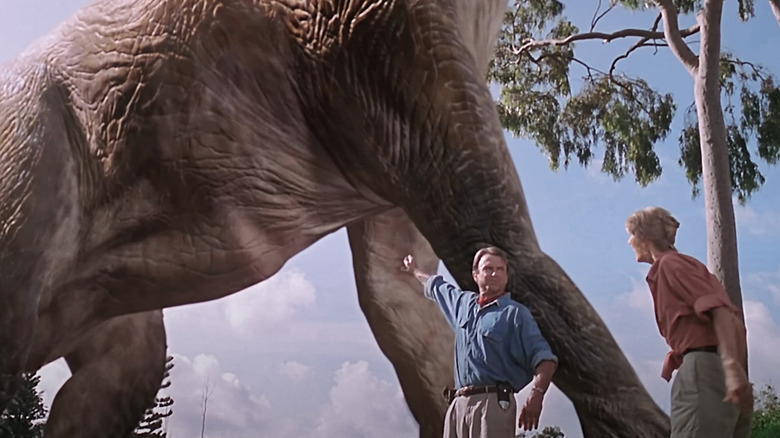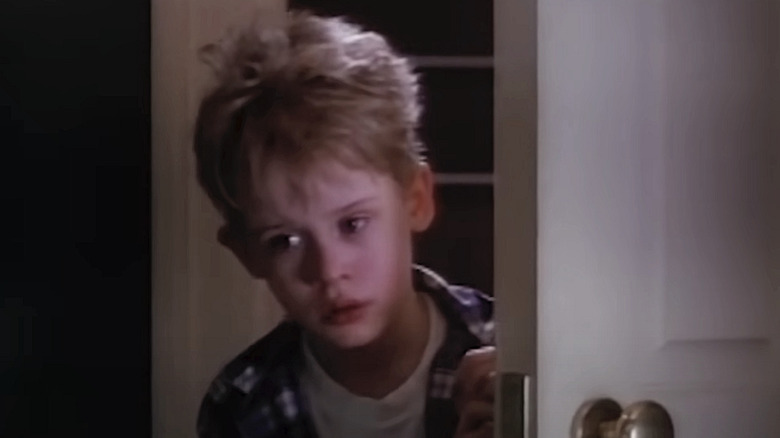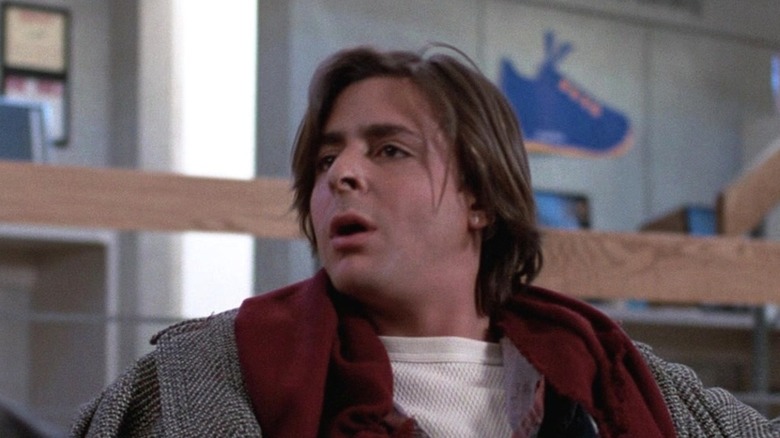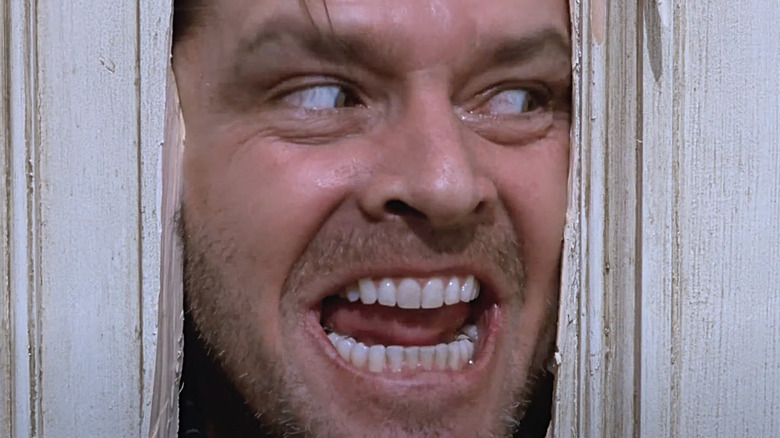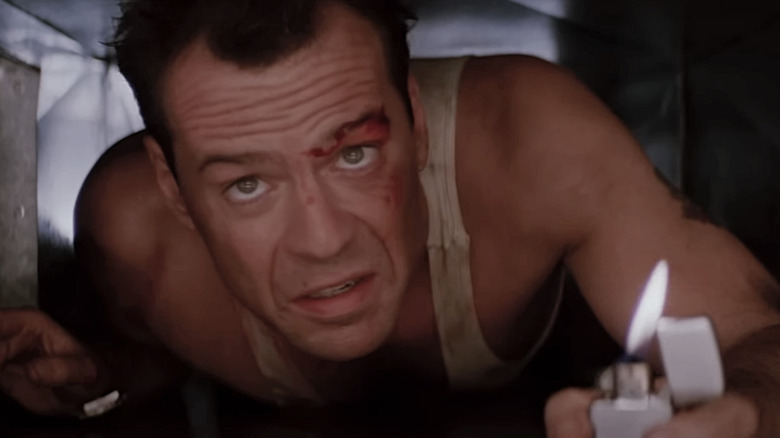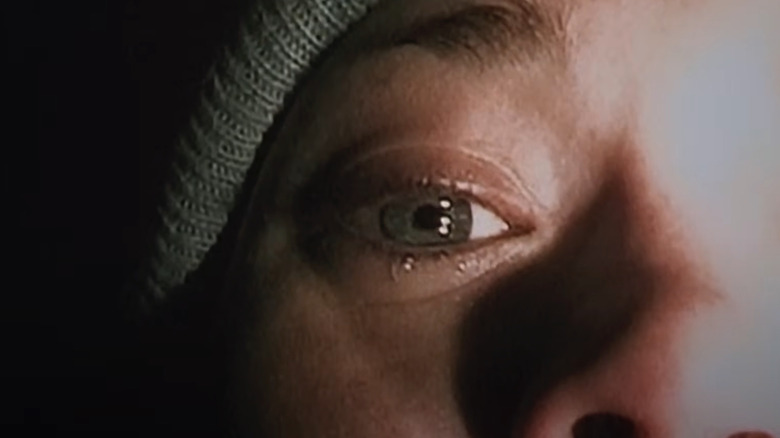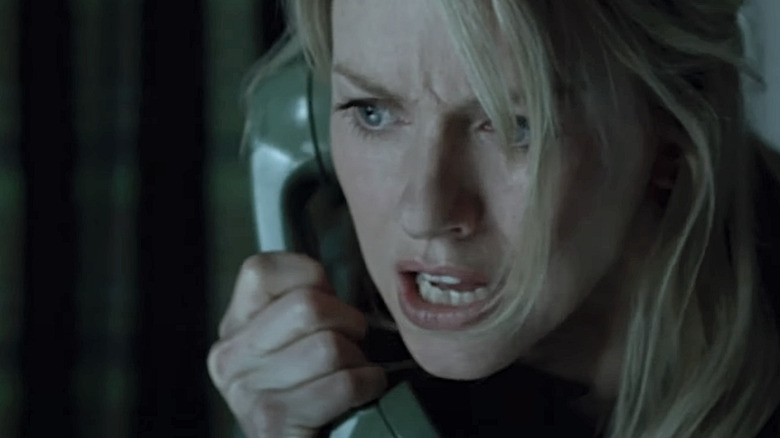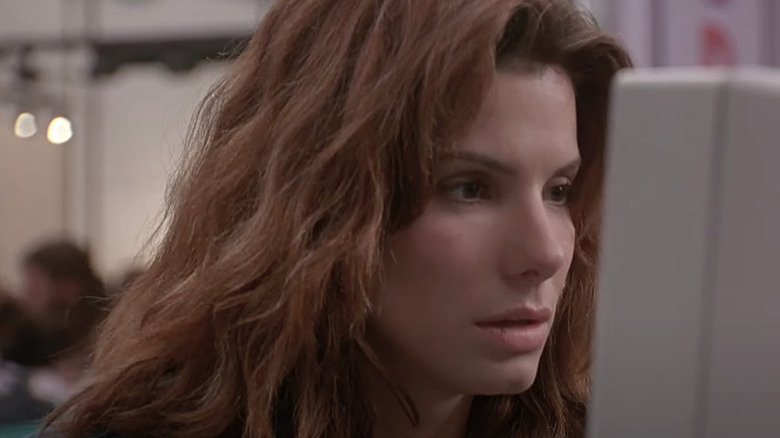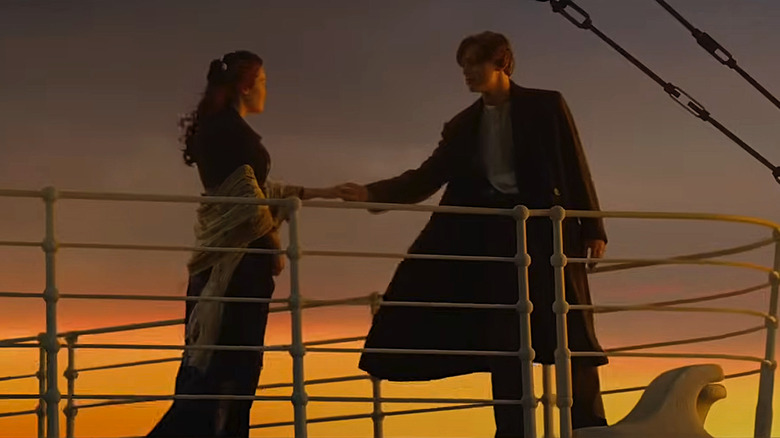How Modern Tech Would Completely Ruin These Classic Movies
Once upon a time, movies had a lot more freedom. Scriptwriters could breathe and get creative and weren't greatly shackled by the technology of the time. Characters could make bad decisions, miss each other by seconds, and walk straight into danger without someone sending a timely text message to warn them. Whole storylines hinged on someone being in the wrong place at the wrong time or missing a crucial phone call. If you introduced modern technology to these movies, many of them would be reduced to boring five-minute shorts.
The supply of movies that could be ruined by today's tech is pretty much inexhaustible. Which is something that could explain why Hollywood struggles to create new films that come anywhere close to the classics of yesteryear. Modern storylines must fit around modern tech. Smartphones, tracking apps, and cloud backup systems are always lurking in the background. And the plot holes they potentially create are usually waiting to be pointed out by the self-proclaimed smartest-guy-in-the-room, who inevitably asks, "Why don't they just Google it?"
Modern technology may fix problems in the real world, but in Hollywood, it gives scriptwriters headaches. It's so hard to build tension when any halfway competent adult could solve the problem with a quick search or call. It's all rather frustrating, and you'd think the studios would just take the easy option and give us a barrage of generic superhero movies instead... oh, wait a minute. So, while they bend over backwards to explain why smartphones have no signal in their films, just for fun, here are some beloved classics that would be utterly ruined by modern tech.
Jurassic Park
Even though the co-founder of Neuralink claims such a park is possible, "Jurassic Park" would still be one movie to bomb in 2025. To begin with, Nedry's plan to steal dinosaur embryos would be a non-starter. His whole plan hinged on nobody noticing a system-wide failure until it was too late. But real-time logs, remote alerts, and access tracking would catch him before he even made it out of the server room. The embryos would stay in the lab, and Nedry would be clearing out his desk by lunchtime.
However, let's say everything up to this point happened as it did in 1993. A modern dinosaur facility would still have backup systems in place in 2025. So a power failure wouldn't shut down the entire park. There would be layered backups, independent circuits, and an IT department that didn't fall apart the moment it rained. Yet, even if the dinosaurs managed a dramatic breakout, as soon as one of them left their enclosure, the system would know. Tracking implants, geofencing, motion sensors — none of it involves Jeff Goldblum desperately waving a flare. And with the kind of budget InGen had, it's not implausible to think a coordinated fleet of heavy-duty drones could deliver enough tranquilizer to take down a rampaging T-Rex.
Then there are the kids. In 1993, they wandered off, got stranded, and spent half the film dodging big, nasty teeth. In 2025, they're tagged and monitored and can send their exact coordinates back to control at any time. The suspense now involves a mildly annoyed technician having to reroute his self-driving jeep. The movie ends with a desperate statement to investors and a shot of a heavily sedated T-Rex with its tongue hanging out, drooling into the dirt. Hardly box office gold.
Home Alone
If the 1990 Christmas classic "Home Alone" were made today, there wouldn't be much of a movie at all. Kevin would wake up, realize the house was empty, and fire off a quick WhatsApp message to his mom. She would see the message, and the whole separation would be sorted before lunch. Well, that's not true; she would still have the CPS to deal with.
Even if Kevin's parents had somehow managed to make their flight without realizing they had left their 10-year-old son behind, when they checked their Ring Cam, they would have soon seen their incompetence as parents. One look at the live feed and they'd witness Kevin trashing the kitchen, sledding down stairs, and throwing aftershave tantrums. And that's before we even get to the bad guys.
The moment bungling burglars Harry and Marv set foot on the property, a Ring Alarm would alert the police. As much as we loved paint cans bouncing off noggins, tarantulas crawling over faces, and red-hot doorknobs burning hands, we would have actually ended up with just a couple of confused idiots cuffed and face down on the lawn within minutes.
The Breakfast Club
Back in 1985, "The Breakfast Club" followed five high school students stuck in Saturday detention with nowhere to go. But the movie wasn't as simple as it sounds. It served to bridge emotional complexity across high school cliques and strived to make each character relatable regardless of social background. The pressure to succeed on Anthony Michael Hall's character Brian and his struggle with mental health resonated strongly with a generation who were just beginning to acknowledge the stress and emotional burnout of the education system. Ally Sheedy's Allison was isolated and emotionally volatile with little direction — the type of teen that was often ignored at that time by mainstream media.
The all-around performances of every actor, including Judd Nelson, Emilio Estevez, and especially Molly Ringwald, gave depth to characters that may otherwise have been thrown in the cliché bin. The balance between humor and pain was real and mirrored the experiences of many students. In fact, the film became a rite of passage — something teens watched to see themselves represented, validated, and understood. Incoming freshmen, in preparation for what high school might throw at them, watched too.
Stick five teenagers in a room today and you'll get silence. No soul-baring confessions. No emotional breakthroughs. No meaningful connections. Everyone would just scroll through TikTok, text people who aren't there, and indulge in social media rabbit holes with AirPods sticking out their ears. Nobody learns a life lesson. Pointless movie.
The Shining
Imagine Jack Torrance's descent into madness didn't unravel with him hammering on a typewriter. If "The Shining" were made today, he would just copy and paste ten thousand lines of "All work and no play makes Jack a dull boy" in a matter of seconds. Then, when his wife Wendy noticed his weird behavior, she would simply just text for help — yes, it's the old 'cellphone ruins the movie plot' again. Okay, the Overlook was a remote hotel, so no signal. But today it would have satellite Wi-Fi, and she'd still be messaging family, checking weather alerts, and googling "how to handle a husband who's lost his mind in a hotel in 2025."
Anyway, a tablet would have given her everything she needed to know beforehand. Hotel reviews on TripAdvisor would say things like "Incredible views, deeply haunted, won't be back." Then there's the hotel's commercial-grade surveillance system, which would be tracking Jack's every move — motion detection, cloud backup, keycard logs, the lot. There would even be panic buttons wired to a Denver dispatch center, and Wendy would have triggered a rescue before Jack had even picked up his axe. And when it came to the maze, she could use an app like Gaia GPS on her cellphone to breadcrumb trail her way out. Wendy would then calmly exit and leave crazy old Jack running around in the snow, wielding his axe and screaming "Here's Johnny" to himself at every turn. Suddenly, the IMDB genre tags read 'slapstick comedy' instead of 'psychological horror.'
Die Hard
The biggest problem "Die Hard" would have if it were made today isn't opinion on whether it's a Christmas movie (it's not, by the way), but rather, how it could be ruined by a few pieces of modern tech. The original 1988 movie works because no one can call for help. The phone lines have been cut, the building is locked up, and our hero John McClane is stuck playing hide-and-shoot with a bunch of crazy, machine gun-wielding Germans. Nobody can deny it's one of the best action flicks ever produced. But if it were made today, it would be a very short movie about a New York policeman in L.A. who opens his cellphone and sends a message to the LAPD. The police show up. End credits.
That said, a criminal mastermind like Hans Gruber would almost certainly have deployed cell jammers beforehand. In that case, there is no call, no signal, and no help. McClane would still end up crawling through vents, but now he'd be doing it with no way to reach anyone. The LAPD stays clueless, the vault gets cracked, and the bad guys walk out rich. Suddenly, that walkie-talkie is just what McClane needs after all.
The Blair Witch Project
"The Blair Witch Project" took found footage movies to a mainstream audience in 1999. Its lo-fi style, shaky camera work, and fake documentary setup turned a budget gimmick into a full-blown genre. Horror suddenly no longer needed gory effects and creepy acting. All that was required was panic, darkness, and the illusion that what was being watched might be real. The movie centered around the found footage of a group of students who had ventured into a Maryland forest to film a documentary on the local Blair Witch legend. It was a creepy mind warp that scared the wits out of cinemagoers worldwide.
However, found footage 'documentaries' like this would need a lot more scriptwriting effort today. The moment they started wandering off-trail, someone would pull out their phone, check Google Maps, and follow the blue dot straight back to the car. Even with no signal, they would surely have had the sense to download an offline map. And if the phone somehow failed, a satellite communicator like the Garmin inReach Mini 2 would have also bailed them out. One SOS, and a rescue team would be en route before night fell.
A modern filmmaking crew like this, students or not, would also likely have a drone among their gear. They would simply fly it overhead to see how to get out. No walking in circles. No screaming into the dark. No nasty, horrible witch. And no real movie, either. Just a boring documentary about a quick hike into the forest where the film crew saw something creepy and legged it.
The Ring
In 2002, "The Ring" combined the classic horror tropes of a videotape and a landline phone to terrify audiences. One watch of the cursed VHS was followed by an ominous ring that, when answered, promised a timely demise within seven days. And that demise involved a creepy girl crawling out of the TV. However, the VHS is dead, and VCRs are no longer manufactured. People have long since stashed any they had in the attic or tried to sell them on to collectors looking for niche electronics at garage sales. Even DVDs are mostly landfill now.
But if someone did manage to get their hands on the original footage, it would likely get ripped, uploaded, and passed around like a meme. Creepy Samara wouldn't be crawling out of a television — she'd be buffering on a cracked phone screen between TikTok clips. And she'd most likely be utterly exhausted with all the crawling around anyway, given that she'd have gone viral to millions around the world. Then there's the screen size problem. Samara crawling out of a 6-inch display doesn't quite have the same impact. While she would still be quite frightening initially, once you'd composed yourself, you would just flick her away or feed her to the cat.
The Net
Remake "The Net" today, and you'd just have Sandra Bullock stuck in a CAPTCHA loop trying to reset her email. In 1995, her character Angela Bennett has her identity erased by a coffee-stained floppy disk and some comically absurd hacking. Her name, address, job, and entire existence are gone within minutes. It was pretty thrilling for cinemagoers back then, but it was also very '90s. A 2025 remake wouldn't be quite so entertaining. Between two-factor authentication, biometric logins, and cloud backups of everything from passport scans to tax returns in Google Drive, wiping someone's life clean isn't particularly easy. Her bank would flag suspicious logins, her devices would demand facial recognition, and her phone would light up with alerts before she'd even hit 'forgot password.'
Then there's her online presence. Even if someone as security-conscious as Bennett didn't have a loud social media history, everyone leaves behind enough digital crumbs to prove they exist. It could be a single tagged photo or a location log. In short, a determined hacker could still make a mess. But completely erasing someone? That would now take weeks of tedious brute-force drudgery, not just a floppy disk and a few keystrokes.
127 Hours
In April 2003, Aron Ralston unfortunately trapped his arm under a huge boulder while hiking Bluejohn Canyon, Utah. With no way of contacting friends or family, he faced an almost impossible decision. By July that same year, the Federal Communications Commission (FCC) had approved the use of Personal Locator Beacons (PLBs), which could send GPS coordinates via satellite to rescue services with a simple button press. Exactly how Ralston must have suffered when discovering that while looking down at his freshly sawn-off arm can only be left to the imagination.
That said, those PLBs were not exactly cheap, and in those early years, many backcountry hikers found it hard to accept being connected to the outside world while out in the wild. But when you're armed with only a cheap imitation Leatherman multi-tool, it's not quite a case of how modern tech would have ruined this movie, but more like how modern tech might have prevented this movie from being made in the first place. Had Ralston been doing his hike today, even the budget-friendly iPhone 16E has built-in emergency satellite SOS. Therefore, Danny Boyle's "127 Hours" dramatization in 2010 would have been pretty lame. Just some guy waiting around for a rescue, getting a bit thirsty, slightly cranky even, and ungratefully cursing under his breath how long rescue services were taking...
Titanic
Another true story (well, the sinking ship part anyway) that wouldn't happen with modern tech is "Titanic." Radar would detect the iceberg from miles away, GPS would pinpoint the ship's exact location, and satellite monitoring would alert them to the approaching ice fields. Furthermore, the ship's advanced navigation systems would warn the crew of the impending iceberg. There would easily be enough time to steer clear while the captain sips tea and complains about just how boring modern sailing has become.
But, let's just say the captain then lost his marbles and tried his chances with the iceberg. Satellite phones would have connected to rescue services globally within minutes, making sure all 2,200 people on board survived. That said, a modern hull would have had a much better chance of surviving the impact anyway. The real tragedy is that we'd be stuck with a three-hour movie about uneventful ocean travel and successful emergency protocols. No romance, no drama, just efficient maritime safety procedures. Jack would have survived and made it to New York. Then, hopefully, he would have changed his name to Amsterdam Vallon, and everyone would have gone to the cinema to see "Gangs of New York" instead. What a relief.
